Cicada Killer Wasps
ENTFACT-004: Cicada Killer Wasps | Download PDF
by Lee Townsend, Extension Entomologist
University of Kentucky College of Agriculture
Mild mannered female cicada killer wasps are active across Kentucky during the summer, intent on their tasks of 1) digging underground burrows and 2) provisioning them with paralyzed cicadas that will be food for their grub-like larvae. The wasps will be very focused on these tasks for several weeks.
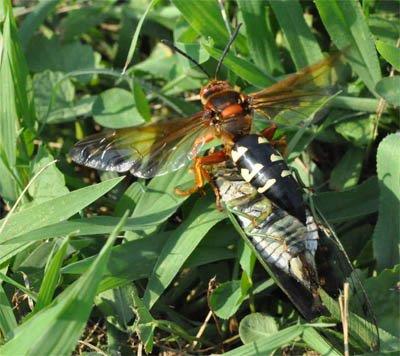
Fig 1. A female cicada killer approaches her burrow with a cicada.
Tall grass does not seem to keep them from locating the entrance.
Why are cicada killers so abundant in some areas? These solitary wasps choose sites with specific characteristics: well-drained, light-textured soils in full sunlight that are near trees harboring cicadas. They may dig along sidewalk or patio edges, in flower beds, gardens, or lawns. As much as 100 cubic inches of soil may be brought to the surface as tunnels are formed. This can be unsightly in highly managed turf and the accumulations may smother grass. Sometimes skunks may dig up areas that have been extensively tunneled by the wasps to feed on cicadas and wasp larvae.
Large aggregations of cicada killers can build up over time. An estimated 40% of the developing larvae (a dozen or more per tunnel) may emerge as adults the following year so numbers can increase rapidly.

Cicada Killer Stinger
Are cicada killers dangerous? Females have significant stingers which they plunge into cicadas to inject venom that paralyzes them. Without doubt, their stings are painful. However, they are not aggressive and do not have nest-guarding instinct of honey bees and hornets. You can walk through areas where they are active without attracting attention.
The buzzing noise that the wasps make and the warning colors on their wings and bodies intimidate and discourage predators that see them as a large meal. When attacked, females will use their stinger to protect themselves.
Males lack stingers but are territorial. They will approach anything that enters “their area”, including walkers, people mowing or using weed-eaters, or riding tractors. They may hover and challenge trespassers but are harmless. That can be easy to forget when staring down a big wasp.
Will cicada killers harm pets? Some dogs and cats may catch cicada killers but usually only once. Those that pick females probably will be stung, remember it, and associate the experience with the buzzing sound and warning colors. Some may have a severe reaction to the venom, especially if stung in the mouth. If that is suspected, the animal should be taken to a veterinarian immediately. Wasp flight begins in early morning and can continue until dusk. Wasps remain in their burrows at night so encounters can be avoided by managing the activity of the pet.
Can cicada killers cause damage?
Female cicada killers dig extensive tunnels where their young will be raised, displacing several pounds of soil in the process. Occasionally, it can result in some damage, such destabilizing a brick patio laid on sand. This is an instance when control may be needed.
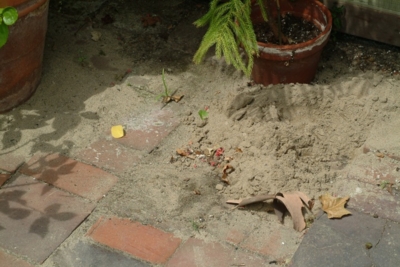
Fig. 3. Sand excavated by cicada killer wasp
Cicada killers may dig in the loose soil in vegetable gardens or flower beds. A burrow at the base of a plant may disrupt its root system. If only a few plants are affected, drenching the area around their bases with water is probably the best approach. The wasps do not like wet soil so they may abandon the site. Watering the plants thoroughly will settle soil back around the roots giving them a chance to survive. Do not drench soil around plants with an insecticide mix because it may damage the roots and/or result in a residue in the plant.
Cicada killers may begin to dig in sandy areas on playgrounds or in golf course sand traps. If practical, keep these areas wet or regularly churn the sand to discourage wasps from establishing their tunnels.
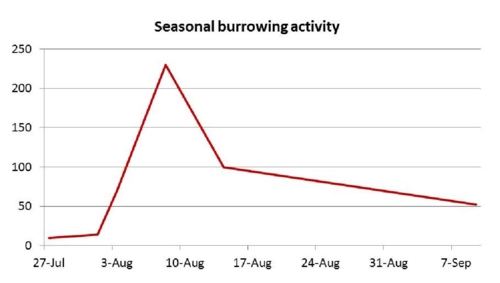
Fig. 4. Cicada killer wasp burrowing activity recorded during Kingwood, WV study (1989).
Can cicada killer wasps be controlled?
Control may be desirable in situations where physical damage is occurring or the presence of the insects is causing significant distress. The wasps were controlled in a West Virginia study by sprays of the pyrerthroid insecticides (cyfluthrin or cyhalothrin). Applications were made directly into the burrows or only to the entrances where the wasps contacted the insecticides as they entered and left. Broadcast sprays over the area where cicada killers were nesting were not effective in reducing their numbers.
Will cicada killers every go away? These wasps will stay and thrive where their basic needs are met. Even if aggressive control measures kill the inhabitants, the site will remain attractive to new settlers in ensuing years.
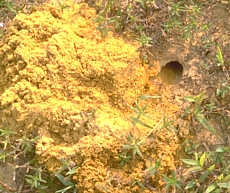
Cicada Killer Burrow
What are the tunnels like?
Cicada killer tunnels usually have a distinctive U-shaped collar of loose soil around the opening. Individual tunnels are can range from 30- to 70-inches long and may run 12- to 15-inches below the surface. The first chamber is about a foot or so from the entrance. There are an average of 15 egg-shaped side chambers an a tunnel, each containing 1 to 3 paralyzed cicadas and an egg which hatches in 2 to 3 days. The grub-like wasp larva feeds for about 10 days, leaving only the cicada's outer shell. During the fall, the larva spins a silken case, shrinks, and prepares to overwinter. Development will be completed when wasps emerge next summer. There is one generation each year.
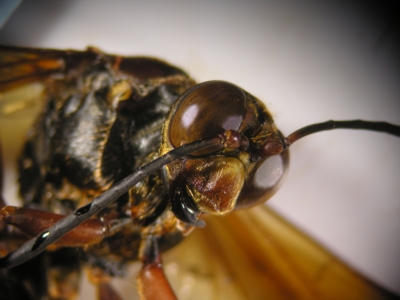
Cicada Killer Detail
Revised: 7/12
CAUTION! Pesticide recommendations in this publication are registered for use in Kentucky, USA ONLY! The use of some products may not be legal in your state or country. Please check with your local county agent or regulatory official before using any pesticide mentioned in this publication.
Of course, ALWAYS READ AND FOLLOW LABEL DIRECTIONS FOR SAFE USE OF ANY PESTICIDE!
Images: Ric Bessin, University of Kentucky Entomology
